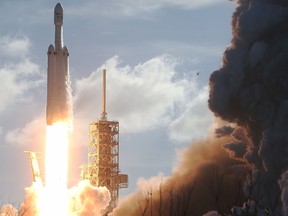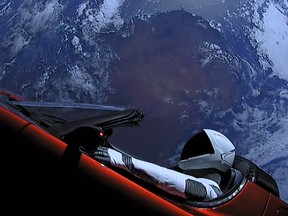A red sports car belonging to Tesla and SpaceX founder Elon Musk was launched into orbit in 2018. It was briefly believed to be an asteroid by an amateur astronomer this week
Article content
An object that was incorrectly identified by an amateur astronomer as an asteroid has turned out to be a Tesla Roadster.
Earlier this month, on Jan. 2, a new asteroid called 2018 CN41 was announced by the Minor Planet Center at the Harvard-Smithsonian Center for Astrophysics. The next day, however, they posted a notice to say it was being deleted.
In a bizarre twist, the centre said the object was actually a Tesla Roadster.
Advertisement 2
Article content
The vehicle, a red sports car belonging to Tesla and SpaceX founder Elon Musk, was launched into orbit in 2018. It was sent into space aboard SpaceX’s Falcon Heavy rocket, CNN reported, which was called the world’s most powerful rocket at the time.

There was even some foreshadowing of the possibility that the vehicle could indeed be mistaken for an asteroid. Space expert and asteroid tracker Marco Langbroek told CNN in 2018 that it was “difficult to predict how the orbit will evolve” and “it’s certainly possible that it will be mistaken for an asteroid.”
After Musk announced that the Roadster would travel to space, one person on X asked why.
“I love the thought of a car drifting apparently endlessly through space and perhaps being discovered by an alien race millions of years in the future,” he said in a post on X in December 2017.
Article content
Advertisement 3
Article content
Meanwhile, the amateur astronomer who identified the would-be asteroid was disappointed but called the entire experience interesting, according to space publication Astronomy. The Turkish man did not wish to be named.
He used software that he wrote in his free time “to parse through the (Minor Planet Center’s) public archive of observations of objects, which anyone can peruse in search of asteroids and other small solar system bodies,” the publication said.

The false finding raised issues of transparency when it comes to space. These concerns were brought up by the American Astronomical Society in September 2024.
The group said it believes that “spaceflight activities in cislunar and interplanetary space should be conducted in an open and transparent way.”
“Such transparency is essential for promoting space situational awareness, reducing interference between missions, avoiding interference with observations of natural objects, including observations of potentially hazardous asteroids, and ensuring the peaceful exploration and use of outer space, including the Moon and other celestial bodies,” according to its statement.
Advertisement 4
Article content
The space dwelling Tesla Roadster was not the only Musk-related object that made headlines recently.
On Wednesday, what appeared to be a fireball was seen streaked across the night’s sky.
It turned out to be a Starlink internet satellite lighting up the American Midwest. Starlink satellites use a low Earth orbit to deliver broadband internet, per its website. The satellites are launched by SpaceX.
A video of the incident was posted online by the American Meteor Society.
Advertisement 5
Article content
Jonathan McDowell, a scientist at the Harvard-Smithsonian Center for Astrophysics, also posted about the fireball on X.
He noted that the satellite had been steadily falling from orbit since Dec. 6, 2024. However, it appeared to reenter “over the southern Wisconsin/Michigan area” and was “widely observed from neighbouring regions including Chicago,” wrote McDowell in another post.
The American Meteor Society has been keeping records of fireball reports since 2005. It received dozens of such reports along with videos and images this week from those who witnessed the satellite in the sky.
The satellite, Starlink 5693, was launched at the Kennedy Space Center in Florida in February 2023, according to research and development centre Aerospace.
At the end of its lifespan, satellites use “electric thrusters to lower the orbit to about 250 (kilometres). Then it’s switched off and the atmosphere drags it in over the next week or so,” McDowell said on X.
“It will almost completely burn up. They are retiring and incinerating about 4 or 5 Starlinks every day at the moment, spread across the world, sometimes you get one at night time in the U.S.,” he said.
Recommended from Editorial
Article content








